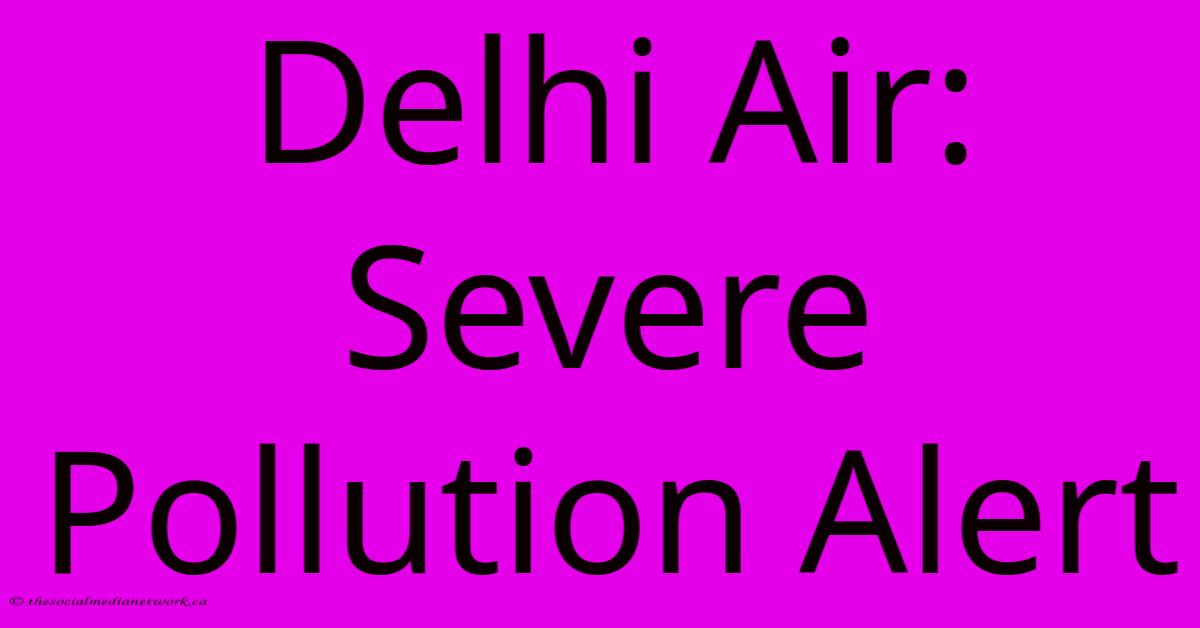Delhi Air: Severe Pollution Alert

Discover more detailed and exciting information on our website. Click the link below to start your adventure: Visit Best Website meltwatermedia.ca. Don't miss out!
Table of Contents
Delhi Air: Severe Pollution Alert – A Respiratory Emergency
Delhi's air quality frequently plunges into a crisis, triggering severe pollution alerts. This isn't just an inconvenience; it's a public health emergency impacting millions. Understanding the causes, consequences, and solutions is crucial for navigating this recurring problem.
The Causes of Delhi's Air Pollution Crisis
Delhi's air pollution is a complex issue stemming from a confluence of factors:
1. Vehicular Emissions: A Major Contributor
The sheer volume of vehicles on Delhi's roads, coupled with a high proportion of older, poorly maintained vehicles, contributes significantly to the particulate matter (PM2.5 and PM10) and other pollutants in the air. Traffic congestion exacerbates this problem, leading to prolonged exposure to exhaust fumes.
2. Industrial Emissions: A Persistent Threat
Industrial units, both large and small, release a range of pollutants into the atmosphere. Lack of stringent regulations and enforcement often allows industries to operate without adequate pollution control measures, further degrading air quality. Industrial emissions are a particularly significant source of harmful gases and particulate matter.
3. Construction Activities: Dust and Debris
Rapid urbanization and construction activities generate vast amounts of dust and debris, significantly impacting air quality. Poor construction practices and a lack of effective dust mitigation measures contribute to this problem. Construction dust is a major source of PM10 pollution.
4. Seasonal Factors: Stubble Burning and Weather Patterns
The burning of agricultural stubble in neighboring states during the harvest season is a major contributor to Delhi's air pollution, particularly during the winter months. Stubble burning leads to a sharp increase in PM2.5 levels. Unfavorable meteorological conditions, such as temperature inversions and low wind speeds, trap pollutants close to the ground, worsening the situation.
Health Impacts of Severe Air Pollution
Breathing Delhi's polluted air has severe consequences for public health:
- Respiratory problems: Increased rates of asthma, bronchitis, and other respiratory illnesses.
- Cardiovascular diseases: Air pollution is linked to heart attacks, strokes, and other cardiovascular problems.
- Eye irritation: Exposure to pollutants can lead to eye irritation, burning, and watering.
- Skin problems: Air pollution can exacerbate existing skin conditions and trigger new ones.
- Increased risk of cancer: Long-term exposure to air pollution is linked to an increased risk of lung and other cancers.
Children and the Elderly: The Most Vulnerable
Children and the elderly are particularly vulnerable to the harmful effects of air pollution due to their developing or compromised respiratory systems. Protecting vulnerable populations requires immediate and decisive action.
What Can Be Done to Improve Delhi's Air Quality?
Addressing Delhi's air pollution requires a multi-pronged approach:
- Stricter vehicle emission standards: Implementing and enforcing stricter emission standards for vehicles, promoting the adoption of electric vehicles, and improving public transportation.
- Improved industrial regulations: Strengthening regulations on industrial emissions and ensuring strict enforcement.
- Effective dust control measures: Implementing effective dust control measures at construction sites and promoting green spaces.
- Sustainable agricultural practices: Promoting sustainable agricultural practices to reduce stubble burning and explore alternative methods of crop residue management.
- Public awareness campaigns: Educating the public about the dangers of air pollution and promoting individual actions to mitigate its impact.
- Real-time air quality monitoring: Strengthening air quality monitoring systems to provide real-time data and inform public health advisories.
Individual Actions: Individuals can also contribute by using public transport, cycling, or walking whenever possible; reducing their energy consumption; and supporting sustainable businesses.
Conclusion: A Collective Responsibility
The severe pollution alerts in Delhi highlight the urgent need for collective action. Addressing this crisis requires a collaborative effort from the government, industries, individuals, and neighboring states. Only through concerted and sustained efforts can we hope to improve Delhi's air quality and protect the health of its citizens. The future of Delhi's air quality depends on our collective commitment to finding sustainable solutions.

Thank you for visiting our website wich cover about Delhi Air: Severe Pollution Alert. We hope the information provided has been useful to you. Feel free to contact us if you have any questions or need further assistance. See you next time and dont miss to bookmark.
Featured Posts
-
Delhi School Reopening Mid Day Meal Air Quality
Nov 26, 2024
-
Growing Interest In Abr Holdings Md
Nov 26, 2024
-
Stolen Truck 1 5 M In Oculus Headsets
Nov 26, 2024
-
Ravens Vs Chargers Live Game Updates
Nov 26, 2024
-
Oil And Gas Automation Market Size 2032
Nov 26, 2024
